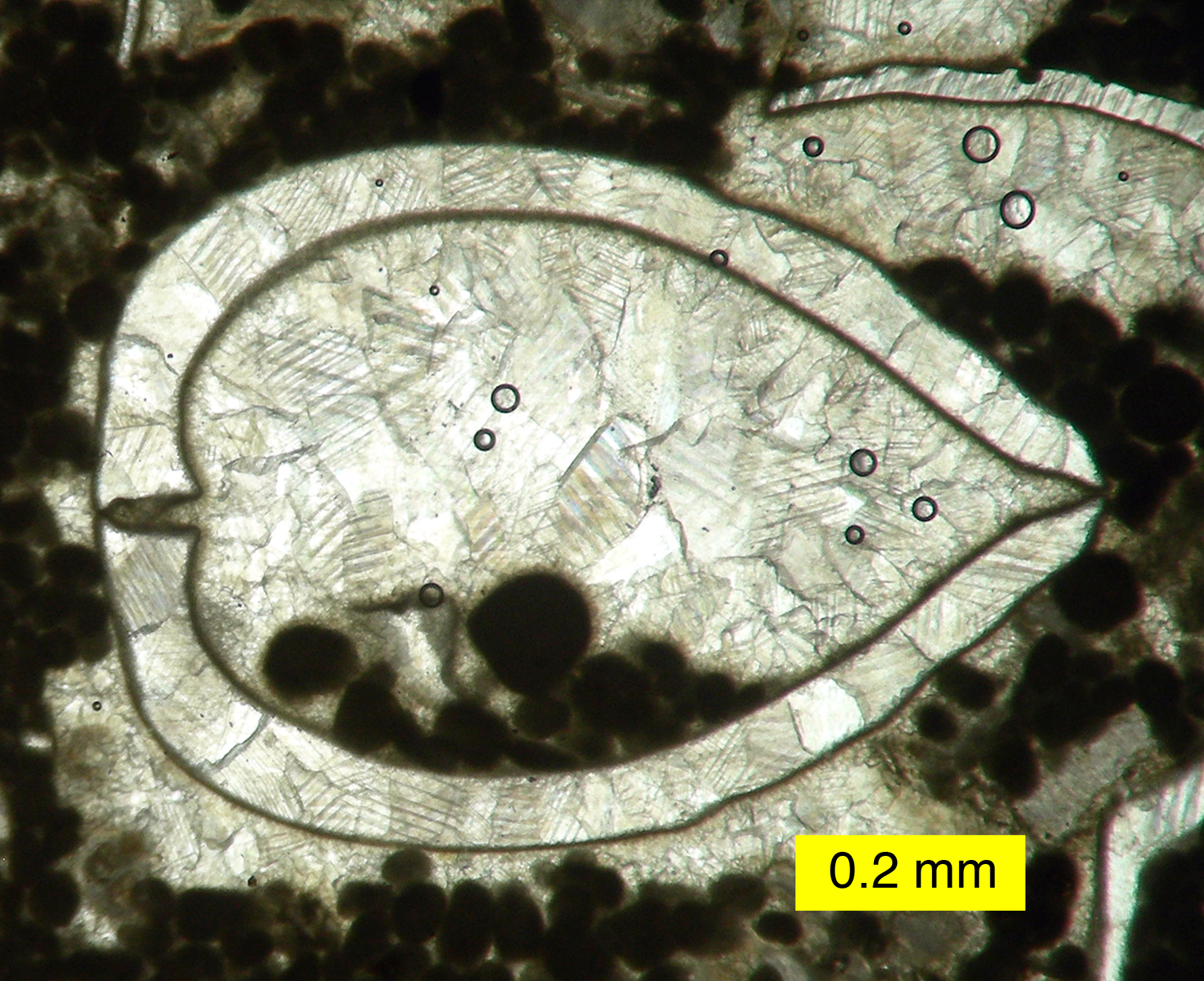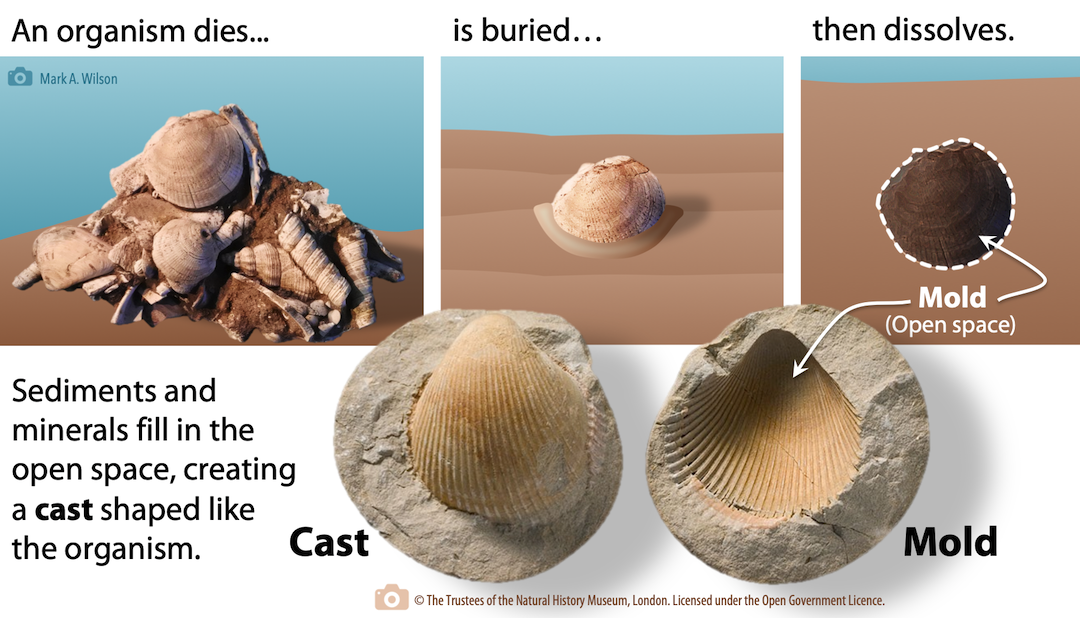Types of Fossil Preservation
There are many different ways that fossils may be preserved. Three main types are:
- Unaltered preservation
- Re-formed preservation, and
- Indirect preservation
Unaltered Preservation
An entire organism is preserved only in very rare circumstances. This can include insects trapped in amber, organisms naturally mummified in dry desert air, frozen in ice, or trapped in low oxygen environments such as tar pits or peat bogs.
Re-formed Preservation
Re-formed Preservation of Hard Parts
The hard parts of most invertebrate organisms are composed of carbonate minerals, silica, enamel/dentine, or chitin. The hard parts of most vertebrates are composed primarily of bone, though cartilage and beta-keratin parts are important. After the organism’s death, these hard parts typically undergo alteration in one of three ways:
1. Permineralization
Originally porous hard parts are preserved when secondary minerals form in the pore spaces. Most vertebrate bones and invertebrate shells are preserved in this fashion. Permineralization helps to stabilize a fossil and it may be more durable than the original.
2. Replacement
A secondary mineral (e.g. calcite, dolomite, silica, pyrite, hematite, limonite) can replace the original material. In some cases, the original fossil materials are replaced in a nearly atom-for-atom manner and the result is a near-perfect replica in a new material.
Both replacement and permineralization are typically the result of the circulation of water through the sediments as part of burial and initial lithification processes (conversion from sediment to a sedimentary rock), or later on as part of weathering.
3. Recrystallization
The originally fine-grained material of a hard part may reorganize into larger crystals of the same mineral (Figure 5.1). No material is added or taken away and so no alteration in the external form of the fossil takes place. However, any internal structures within the hard parts are usually destroyed. Many carbonate shells (clams, oysters etc.) are composed of aragonite, which is a less stable crystal form with the same chemistry as calcite. Aragonite will typically reorganize into larger crystals of calcite.

Re-formed Preservation of Soft Parts
Carbonization is the most common preservation of soft parts. The tissue undergoes carbonization or distillation in which the volatile components (oxygen, hydrogen, and nitrogen) of the original organic substances are “burned off” during decay leaving behind more complex and nonreactive carbon-rich substances.
Carbonization is caused by heating of the rock as it is buried.
Indirect Preservation
The following are examples of preservation styles in which the original soft or hard parts of the organism have been destroyed, but their character can still be determined from the surrounding sediment.
Molds, Casts, and Imprints
When an organism is buried and sediments lithify around it, the organism creates a mold in the surrounding material (Figure 5.2). If the organism decays and creates a cavity (hollow), sediments may fill that cavity and lithify into a cast. An imprint is formed when an organism is pressed into soft sand or mud sediments and then later removed. The impression then fills up and an imprint of the organism is preserved.

Tracks, Trails, and Burrows (Trace Fossils)
Tracks and trails are formed as organisms move along the surface of soft sediments, and they can be preserved by rapid burial. The hole or burrow left by a burrowing organism is often preserved when it is later filled with some sediment of a different composition. These sediment-filled burrows are of great importance to geoscientists because they indicate the presence of soft-bodied burrowing organisms, such as worms or shrimp, which are not often preserved as fossils.
Coprolites
These are solid excretory waste products of animals that are sometimes preserved in the geologic record. Coprolites have been used by geologists to determine where an animal lived, what its diet may have been, and what its relative size was.
Chemical Fossils
These can be direct or indirect. Direct traces of distinctive organic chemicals preserved in rocks can give clues as to the presence of organisms without the actual preservation of the life form itself. This may the case for bacteria and other microbes where a biochemical “fingerprint” of organic molecules still remains, but the individual cells are not preserved.
Indirect chemical fossils are when there are no original organic molecules preserved, or other direct indicators of life, but the presence of life is evident in the chemistry of the material still preserved. For example, carbon dioxide from the atmosphere may dissolve in a warm tropical ocean and then be precipitated as calcite separate from the influence of any organisms. The stable isotopes of carbon (i.e., the ratio of rare carbon-13 to more common carbon-12) in this inorganic calcite have a particular signature. Bacteria in the same ocean may be producing CO2 while calcite is precipitating, but the stable isotopes of this dissolved carbon dioxide will have a different signature, and so will the calcite. Measuring the stable isotopes of carbon in a sample of calcite may be able to tell you if there were living organisms around when it precipitated.
